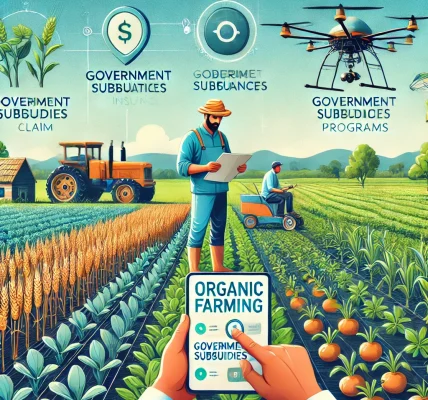Introduction
Agriculture plays a vital role in India’s economy, and the export of agricultural products contributes significantly to foreign exchange earnings. To enhance the competitiveness of Indian agricultural exports, the Government of India has introduced various export promotion schemes aimed at providing financial incentives, infrastructure support, and global market access to farmers and agribusinesses.
This blog explores the major export promotion schemes for agricultural products, their benefits, eligibility criteria, and how farmers and exporters can apply for them.
Importance of Export Promotion in Agriculture
Why is Export Promotion Important?
- Boosts Farmers’ Income – Expanding into international markets increases revenue for farmers.
- Encourages Quality Production – Global demand requires adherence to high standards, improving product quality.
- Enhances Foreign Exchange Earnings – Strengthens India’s economy through export earnings.
- Diversifies Market Access – Reduces dependency on domestic markets by tapping into global opportunities.
Major Government Export Promotion Schemes for Agricultural Products
1. Agriculture Export Policy (AEP) 2018
- Objective: Boost agricultural exports and double farmers’ income by 2025.
- Key Benefits:
- Incentives for exporters to expand in international markets.
- Encouragement of value-added exports over raw produce.
- Financial assistance for modernizing agriculture infrastructure.
- Eligibility:
- Farmers, producer organizations, and agribusinesses.
- Registration with Agricultural and Processed Food Products Export Development Authority (APEDA).
2. Merchandise Exports from India Scheme (MEIS)
- Objective: Provide financial incentives to offset infrastructural inefficiencies and associated costs.
- Key Benefits:
- Duty credit scrips (financial rewards) for exporting eligible products.
- Assistance for exporters in compliance with international standards.
- Eligibility:
- Registered agricultural exporters.
- Application via Directorate General of Foreign Trade (DGFT) portal.
3. Transport and Marketing Assistance (TMA) for Agricultural Products
- Objective: Reduce transportation and logistics costs for agricultural exports.
- Key Benefits:
- Financial support for freight and marketing expenses.
- Assistance for both sea and air transport.
- Eligibility:
- Registered exporters of eligible agricultural products.
- Application through APEDA.
4. Agricultural and Processed Food Products Export Development Authority (APEDA) Schemes
- Objective: Promote the export of processed food, fruits, and other agro-products.
- Key Benefits:
- Financial assistance for packaging, branding, and market research.
- Subsidies for organic certification and quality control measures.
- Eligibility:
- Farmers, exporters, and producer groups.
- Registration with APEDA is mandatory.
5. Market Access Initiative (MAI) Scheme
- Objective: Support Indian agricultural exporters in global branding and market expansion.
- Key Benefits:
- Financial support for participation in international trade fairs.
- Assistance for market research and brand promotion.
- Eligibility:
- Exporters, trade bodies, and industry associations.
- Application through Department of Commerce, GoI.
6. Remission of Duties and Taxes on Exported Products (RoDTEP)
- Objective: Refund embedded duties and taxes to enhance agricultural export competitiveness.
- Key Benefits:
- Rebates on taxes like VAT, electricity duty, and fuel surcharges.
- Enhances price competitiveness of Indian agricultural exports.
- Eligibility:
- All agricultural exporters.
- Application through DGFT online portal.
How to Apply for Agricultural Export Promotion Schemes?
Step 1: Register with Export Promotion Bodies
- Farmers and exporters must register with APEDA, DGFT, or respective state export boards.
- Obtain an Importer-Exporter Code (IEC) from DGFT.
Step 2: Identify the Suitable Scheme
- Check eligibility criteria for MEIS, TMA, MAI, or RoDTEP based on the export product.
- Visit government portals like apeda.gov.in or dgft.gov.in.
Step 3: Prepare Required Documents
- Aadhaar Card/PAN Card for identity verification.
- Export agreement/contracts with buyers.
- Bank account details for financial incentives.
- Product quality certifications (if applicable).
Step 4: Submit the Application
- Online: Apply through DGFT, APEDA, or relevant government portals.
- Offline: Submit applications via regional export facilitation centers.
Step 5: Approval and Disbursement
- Authorities review applications and verify documents.
- Financial incentives or reimbursements are processed upon approval.
Best Practices for Exporting Agricultural Products
- Ensure Quality Compliance – Follow global quality and safety standards.
- Invest in Value Addition – Processed products fetch higher prices.
- Use Sustainable Practices – Organic and eco-friendly farming attract premium markets.
- Leverage Digital Platforms – Online marketplaces help expand reach.
- Collaborate with Export Promotion Agencies – Seek guidance from APEDA and DGFT.
Conclusion
The Government of India’s export promotion schemes for agricultural products provide essential support for farmers and exporters looking to enter international markets. By leveraging financial incentives, transport assistance, and quality certifications, Indian agricultural businesses can enhance their global competitiveness and profitability.
Farmers and agribusiness owners should take advantage of these schemes to boost exports, increase revenue, and contribute to India’s economic growth.




